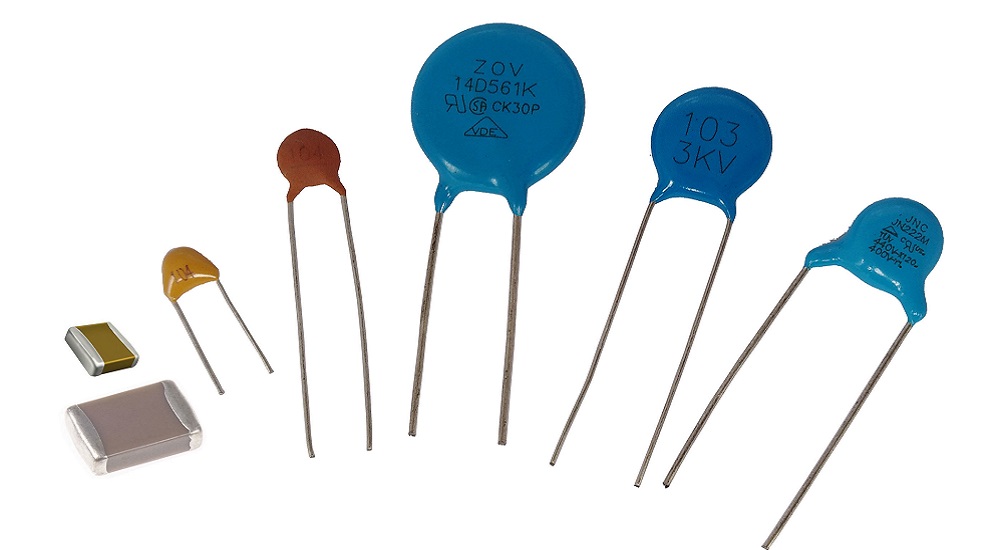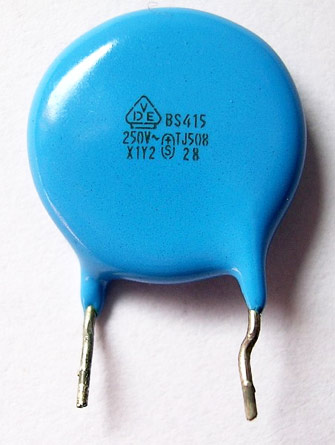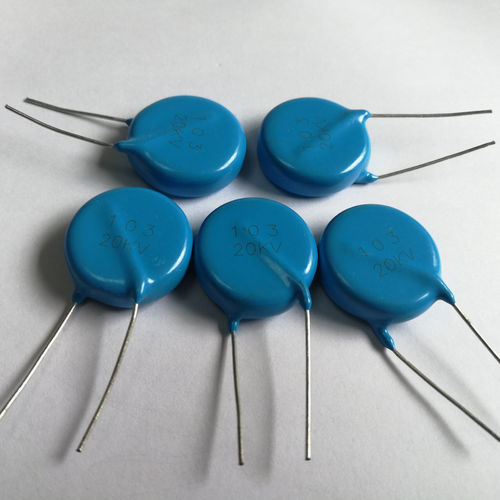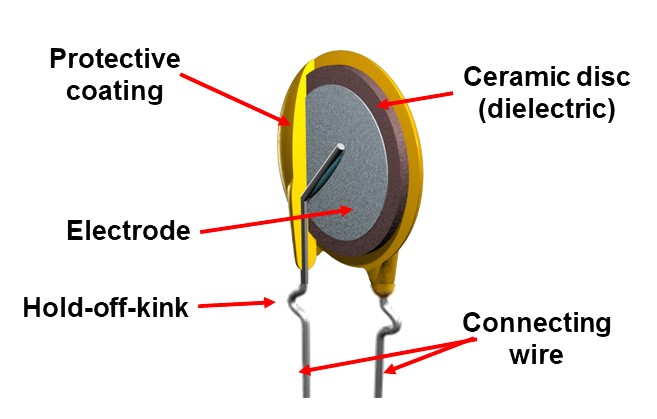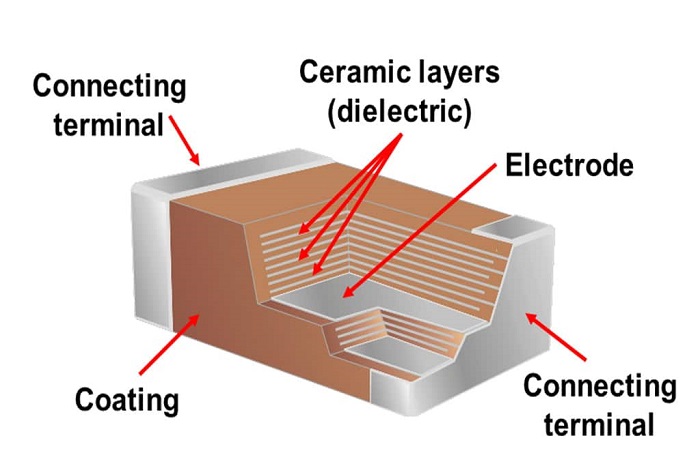The ceramic capacitor, which employs a ceramic layer as the dielectric between two or more conductive charge storage plates, is one of the most significant types of capacitors. In this new blog post of Linquip, you will find out about the origin, definition, construction, different uses, and some more information about ceramic capacitors. So, please follow the post.
Let’s first briefly know the Origin of the Ceramic Capacitor and its Types
Ceramic dielectric capacitors, one type of ceramic capacitor, were created around 1900. In the late 1930s, it was discovered that by adding titanate to ceramics, the dielectric constant could be doubled leading to less expensive ceramic dielectric capacitors.
Following the discovery of the insulating characteristics of “Barium titanate”, the major raw material for today’s ceramic capacitors, the ceramic capacitor was initially employed in military electronic equipment about 1940. “Ceramic laminate capacitors” then became commercially accessible about 1960. Because of the fast expansion of hybrid integrated circuits, computers, and portable electronic devices, it had become a key component of electronic gadgets by 1970.
Ceramic dielectric capacitors presently account for around 70% of the total capacitor market. One of the capacitor development trends is miniaturization, which means that the capacitor has the most possible capacity in the smallest possible volume.
What is the ceramic capacitor?
Capacitors, believe it or not, are one of the essential building components of our contemporary world. They charge storage devices that may be found in anything from car’s speakers to camera’s flash. Ceramic capacitor is the most frequent type of capacitor found in electrical circuits. Because of its small physical size and great charge storage capacity, a ceramic capacitor is employed. Ceramic capacitor receives its name from the fact that it uses ceramic as a “dielectric” material.
In detailed, the ceramic capacitor was invented as a replacement for “mica dielectrics”. It is divided into two classes. The Class 1 ceramic capacitor is made of finely ground paraelectric materials for excellent stability. Ferroelectric materials are on the other hand used to make the Class 2 ceramic capacitor. When compared to class 1 components, the class 2 capacitor has more capacitance per volume but poorer precision and stability.
This is related to the precision and tolerance characteristics of the ceramic capacitor. As mentioned above, there are now two classes of the ceramic capacitor: class 1 and class 2. The Class 1 ceramic capacitor is utilized when great stability and minimal losses are required. This type is highly accurate, and the capacitance value remains constant independent of voltage, temperature, or frequency. The Class 2 ceramic capacitor has a high capacitance-to-volume ratio and is utilized in less sensitive applications. The thermal stability in the operational temperature range is typically 15%, and nominal value tolerances are around 20%.
In more words, the ceramic capacitor is a fixed-value form of capacitor in which the ceramic material within the capacitor functions as a “dielectric”. This capacitor is made up of several alternating layers of ceramic as well as a metal layer that serves as an electrode. The composition of this ceramic material in this capacitor reveals information about its electrical behavior as well as its uses. The dielectric of a ceramic capacitor is made of “ceramic”. Ceramics, as a recognized “insulator”, were one of the earliest materials utilized in the manufacturing of capacitors.
The Ceramic capacitor is most commonly found as multilayer ceramic chip capacitor (MLCC) package suited for surface-mount soldering, or as single-layer ceramic disk capacitors appropriate for through-hole installation. Know that ceramic capacitor is a type of non-polarized capacitor.
What is the Construction and property of ceramic capacitors?
Ceramic disc capacitor is made by covering a ceramic disc on both sides with silver contacts. It can be constructed from many layers to produce higher capacitances. Ceramic disc capacitor is typically through-hole component that is dwindling in use owing to their size. If capacitance values allow, MLCCs are utilized instead. Ceramic disc capacitor has capacitance values ranging from 10pF to 100F and voltage ratings ranging from 16 volts to 15 kV and higher.
A ceramic capacitor may be securely linked to an alternating current source, and this is because it is not polarized. Moreover, because of low parasitic effects like resistance or inductance, this capacitor has a high-frequency response.
What are the Applications for ceramic capacitor?
Ceramic capacitor may be used as a general-purpose capacitor since it is non-polarized and come in a variety of capacitances, voltage ratings, and sizes. It is the most common capacitor used in electrical circuits. The ceramic capacitor is typically employed in applications that need a small physical size as well as a significant charge storage capacity. We already know that a capacitor is used to store electric charges. The mechanism utilized to hold the electric charge in all capacitors is the same, but the substance used to create the capacitor varies.
Other various applications of ceramic capacitors include:
- Tone compensation
- Volume control RF bypass
- Lighting ballasts
- Automatic volume control filtering
- Antenna coupling
- Resonant circuit
How is the Ceramic Capacitor Advantageous?
The advantages of the ceramic capacitor include:
- Ceramic capacitor is available in any size or shape on the market, and it is also affordable and lightweight.
- It can be built to sustain a high enough voltage.
- The performance of the ceramic capacitor is reliable. It can be used in hybrid integrated circuits.
- The physical structure of this capacitor is exceedingly compact, and it is ideally suited for the application of AC signals due to its non-polarized nature.
- Ceramic capacitor increases signal interference suppression, such as radiofrequency suppression and electromagnetic interference suppression. This capacitor is inexpensive and can tolerate voltages of up to 100 volts.
What are the Disadvantages of Ceramic Capacitor?
The disadvantages of the ceramic capacitor, on the other hand, include:
Ceramic capacitor has a capacitance value of less than one microfarad and is also responsible for the Microphonic effect in circuits. It means extremely high capacitance levels are not achievable.
Ceramic capacitor with extremely high voltages is not available. That is, it cannot resist high voltages. Because it has a high influence on the dielectric contained in it. As a result, there is a breakdown.
There is a very important question about ceramic capacitor:
Is it possible to replace all electrolytic capacitors with the ceramic capacitor?
We can accomplish this if we can get a ceramic capacitor of the appropriate value. Ceramic capacitor is more stable, last longer, has greater voltage ratings, and is not polarized. So, we need to be prepared to notice a significant size change.
Summary
We attempted to provide a clear image of the ceramic capacitor, bringing about the origin, construction, uses as well as the pros and cons. As mentioned in the post, a ceramic capacitor is one with a ceramic dielectric as the dielectric material. Ceramic material is utilized to make the dielectric in a ceramic capacitor, while conductive metals are used to make the electrodes. However, you can get more information about the ceramic capacitor by registering in Linquip and leaving your comments. We are eagerly looking forward to receiving your comments.
Buy Equipment or Ask for a Service
By using Linquip RFQ Service, you can expect to receive quotations from various suppliers across multiple industries and regions.
Click Here to Request a Quotation From Suppliers and Service Providers
Read More In Linquip
- What is a Non-Polarized Capacitor? Types & Function
- Difference between Capacitor and Inductor- Capacitor vs. Inductor
- What is Capacitor and How it Works?
- Difference Between Condenser and Capacitor in a nutshell 2022
- What is a Paper Capacitor?
- What is Paper Capacitor Used for?
- What is Mica Capacitor Used for?
- What is Electrolytic Capacitor? Usage & Application
- What is Film Capacitor & What is it used for?
- 7 Types of Capacitors and Their Uses
- What are Mica Capacitors? Comprehensive Overview
- What is Electrolytic Capacitor?
- What is Film Capacitor? Different Types & Working
- What is Ceramic Capacitor? A Basic Description
- Types of Capacitors: All You Need to Know
- Difference Between Heat Exchanger and Condenser
- Difference Between Condenser and Evaporator

